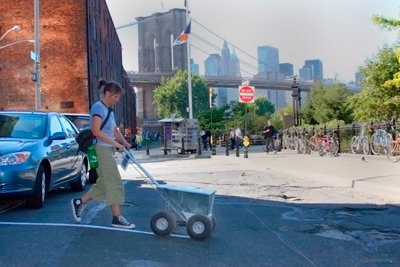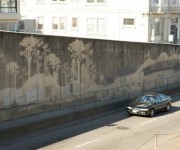Photo: c/o MooseStreet artist Moose Benjamin Curtis was having some difficulty with the police. The officers had just arrested him for creating designs on a wall in South London. But it was complicated — as things often are when Moose is involved.
You see, Moose doesn’t use spray paint or wallpaper paste — the usual tools of this trade. Instead, he wields scrub brushes, old socks, cleaning fluid, and, when he’s living large, a high-pressure hose. He creates images by cleaning shapes into filthy urban surfaces such as retaining walls, signs, and tunnels.
People have called it “reverse graffiti,” “clean graffiti,” and “negative space.” Moose prefers “grime writing.” He has called himself “a professor of dirt.”
He is not the only one working in this medium: Brazillian artist Alexandre Orion scrubbed a gallery of skulls onto the wall of a tunnel in Sao Paolo a few years back; street artist Banksy has also used the technique. But Moose is a pioneer — and a bit of a character to boot.
On that day in South London, when Moose asked the officers what crime he was being charged with, confusion ensued.
“We’re arresting you for criminal damage,” Moose recalls one of the officers telling him.
“The only thing I’ve damaged is dirt,” the artist replied.
“They took that on board,” Moose says. “They were really fumbling around.”
Then the police told him that he had made marks on the wall. “I explained that the marks were made by pollution. If they wanted to arrest the perpetrators of this crime, they should get with the people who had created this pollution.”
The bobbies were probably about to lock Moose up just for being a smartass, but he was saved by the bell. “At about that time, I had to go to the bathroom,” he explains. “So they took me to this pub, and the police officer followed me into the bathroom and stood outside the stall like I was some clean terrorist, randomly going around cleaning things.”
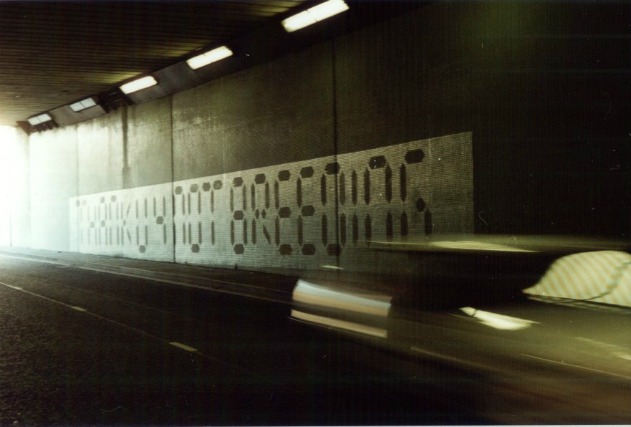 “Thank you for not breeding”: Leeds, U.K., Oct. 1999.Photo: MooseFortunately for our wise-cracking hero, he keeps good company, and while he was taking care of business, his friend and fellow dirt monger (who was apparently aiding in the crime in order to win the heart of a young lady) convinced the police to just let the duo scrub the entire wall — thus eliminating the images they’d created — and call it a day.
“Thank you for not breeding”: Leeds, U.K., Oct. 1999.Photo: MooseFortunately for our wise-cracking hero, he keeps good company, and while he was taking care of business, his friend and fellow dirt monger (who was apparently aiding in the crime in order to win the heart of a young lady) convinced the police to just let the duo scrub the entire wall — thus eliminating the images they’d created — and call it a day.
“Which is a little like stealing a car and then taking it back to where you got it,” Moose says. But who was he to ask questions?
While Moose’s innovative artistic techniques have won him worldwide recognition — one of his best known pieces was in the Broadway Tunnel in San Francisco — they were inspired by simple poverty. He was working for a record label, he says, and they wanted to promote a new album. Lacking the money for signs or advertising, they scrubbed their message into the walls of tunnels around his hometown of Leeds, England.
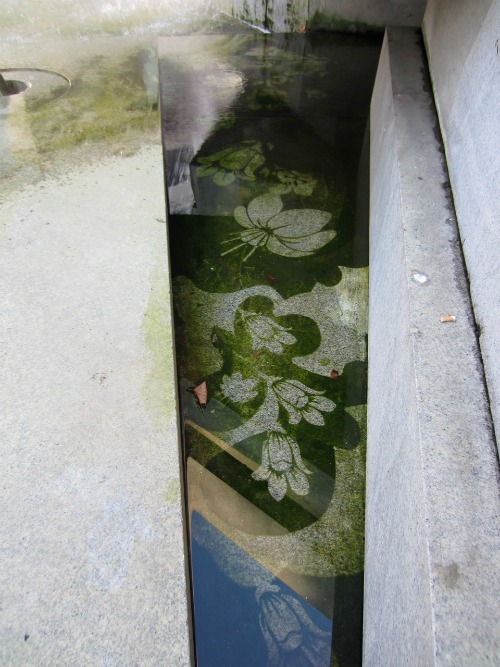 The United Nations Plaza in San Francisco, Oct. 2011.Photo: MooseMoose has since done projects for corporations, local causes, and simply for the fun of it. But he says he gets the most satisfaction out of working with environmental organizations — with which he has an obvious affinity, though he doesn’t consider himself a model of green citizenship.
The United Nations Plaza in San Francisco, Oct. 2011.Photo: MooseMoose has since done projects for corporations, local causes, and simply for the fun of it. But he says he gets the most satisfaction out of working with environmental organizations — with which he has an obvious affinity, though he doesn’t consider himself a model of green citizenship.
“The environmental message [in my art] is unavoidable,” he says. “I’m writing in grime.”
A while back, Moose teamed up with a pack of eco-warriors with Greenpeace. They piled into a zodiac raft, armed with pressure washers, and buzzed across the Thames River to a blackened retaining wall near the House of Parliament. When they’d finished their work, the wall was emblazoned with the message:
“DON’T CHANGE THE CLIMATE. CHANGE THE POLITICS.”
“I love working for Greenpeace. It’s the one time I feel that this art form is put to its best use,” Moose says. “I feel like I’m in the good army when I work with them.”
Still, much of his art takes a more subtle tack. He is fond of carving the forms of flowers and trees onto dirty surfaces, adding organic forms, as delicate as paper cutouts, to the hard edges of the urban landscape.
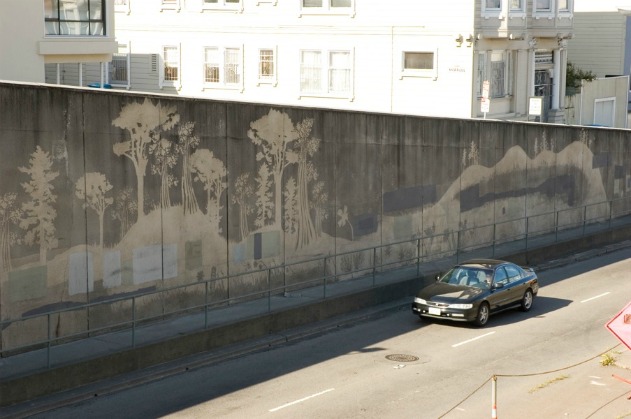 Broadway Tunnel in San Francisco, April 2009.Photo: Moose
Broadway Tunnel in San Francisco, April 2009.Photo: Moose
“I could stand around all day long telling people how what we’re doing is ruining the planet,” Moose says. “But if I can intrigue them enough to look closer, and then shock them with the contrast between where the wall was cleaned and where it was dirty … It’s just a quirky little way of getting the point out to people.”
And if that occasionally puts him at odds with the authorities, it has also won him many fans — including inside the art establishment. He is currently working (with a slew of other artists) on an exhibition called Ghosts of Gone Birds , which uses art, music, and poetry to re-animate extinct bird species.
“I’m cleaning [bird] shadows into the floor around the gallery,” he says. “And you know what it’s like when a bunch of birds take off all at once — I’m trying to create a chaos of little shapes on the side of the wall.”
That is, if he can get permission to work on the wall in the first place. “I have so much trouble getting permission to clean walls, it’s just unbelievable,” Moose says. “It’s just a little bit over people’s heads.”
